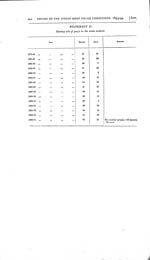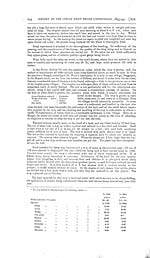Medicine - Drugs > Report of the Indian Hemp Drugs Commission, 1894-1895 > Volume III
(247) Volume 3, Page 243
Thumbnail gallery: Grid view | List view

BULLETIN BY MR. C. BENSON, M.R.A.C. 243
BULLETIN ON THE
CULTIVATION AND MANUFACTURE OF GANJA IN MAD-
RAS, BY MR. C. BENSON, M.R.A.C., DEPUTY DIRECTOR,
AGRICULTURAL
BRANCH, MADRAS.
The true hemp plant
(Cannabis saliva), though grown here and there in
most parts of
the presidency in backyards, is found as a regularly-cultivated
field crop in only two localities,
viz., in the Malayali villages on the Javadi hills in North
Arcot, and in one or two villages in
the Bapatla taluk of Kistna District. It is also raised to a
certain extent in the hilly parts of
Vizagapatam and Ganjam, but there seldom more than a few plants are
grown by each person.
The Javadis are a
low hill rauge covered with jungle, amongst which the
Malayali
villages lie scattered, few of them consisting of more than three
or four huts. Each village has
a small patch of land cleared for cultivation near by, and there,
in almost all cases, a plot or
two of hemp will be found growing. The Malayalis claim to be
Vellalas, but except for pur-
poses of trade and barter have little or no connection with the
people of the plains. They
also claim to alone possess the knowledge necessary for the
manufacture of ganja—a practice
which has been carried on, they state, in these hills from time
immemorial. They attribute
the fact that the growth of the crop is confined to the hills
merely to the ignorance of the
people of the plains, and state that if the latter knew how to deal
with the crop, they would
easily grow it outside the hills.
On the hills cultivation
is carried on in small plots, the natural fall of the ground
pre-
venting any considerable tolerably level area being found in one
place, although to a certain
extent the plots are terraced. In these plots the Malayalis raise
the ordinary dry food-grains
of the country for their own consumption, and with them the hemp
plant alternates, hemp
not being ordinarily taken on the same land in two successive
years. The soil is free, friable,
and open, derived directly from the rocks on which it rests;
thoroughly well-drained, and
appears to be fairly fertile. For hemp it receives a heavy dressing
of cattle dung, without
which it is said to be hopeless to raise the crop. This manure is
spread on the surface in May,
or June, before the first rains allow of ploughing being begun. As
soon as the land is sufficiently
moistened, it is ploughed and the operation is repeated three or
four times at convenient inter-
vals until some time in July, when the seed is sown. Sowing is done
by dropping the seed, at
the rate of five or six sers per acre, in a furrow opened with a
plough, the seed being cover-
ed with soil drawn over it by the feet of the sower. The seed is
sown in rows about three feet
apart, and during the growth of the crop the spaces between the
rows are worked and kept clean
by ploughing and weeding. The young plants appear in about a week
after sowing, and
when about three weeks old they are partially thinned out, and when
they reach to a foot high
they are earthed up by means of a plough, which is run along on
either side of the rows.
This latter process, aided by hand-weeding at intervals of about a
fortnight, thrice repeated,
keeps the whole land clean.
When the crop is about
four months old, the anxieties of the cultivator commence and
the crop has to be examined carefully and frequently, so that any
male plants—called female
by the ryots—may be detected and removed. Detection of the male
plants is only possible
when the flowers appear. Their entire removal is absolutely
essential to securing a crop of
ganja, as otherwise the whole crop runs to seed. The removal of the
male plants is a con-
tinuous process, going on as the plants are detected.
Notwithstanding this care a certain
amount of seed actually sets.
Some time early in
January the harvest begins. It continues up to March. Plants
are
ready for cutting as soon as the leaf turns yellow and begins to
drop. At the same time the
spikes of female flowers also turn yellow. The crop is never cut on
a damp or cloudy day.
In harvesting, the ripe
plants are cut bodily, tied into small bundles, and carried to
the
threshing-floor of the village. There the spikes are stripped off
the stems, with a few of the
leaves, and the stems are thrown away. The material thus collected
is spread out on the floor
in the sun during the middle of the day for three, four, or five
hours, and then loosely rolled in
the hand to work out such seed as may have been formed and to break
up the leaf that remains.
This working also causes the spikes to stick to one another to some
extent. The broken leaf
is then winnowed out, collected, and powdered.
The manufacture then
begins. A closely-woven bamboo basket is taken and dusted
inside
with leaf powder. Into it is placed a layer of the spikes an inch
or an inch and a half deep.
The spikes are then trodden under foot by a man working round and
round on his heels in
the basket four or five times: the man supporting himself on a
stick, whilst the basket is
held steady by two others. If the basket be large enough two men do
the treading, grasping
each other's shoulders to steady themselves. Layer over layer of
the spikes is thus made in
the basket till it is full, each layer being separated from the
next by a little leaf-dust. When
the basket is full, its contents are turned out on a piece of flat
hard ground, and on the top of
Set display mode to: Large image | Zoom image | Transcription
Images and transcriptions on this page, including medium image downloads, may be used under the Creative Commons Attribution 4.0 International Licence unless otherwise stated. ![]()
| India Papers > Medicine - Drugs > Report of the Indian Hemp Drugs Commission, 1894-1895 > Volume III > (247) Volume 3, Page 243 |
|---|
| Description | Volume 3: Appendices. Miscellaneous. |
|---|---|
| Attribution and copyright: |
|




